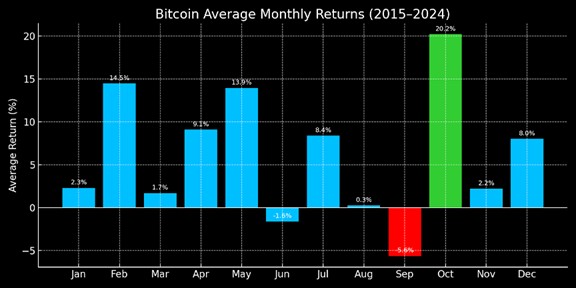"Uptober" 2025: Can Bitcoin repeat its seasonal strength?
For more than a decade, October has carried a reputation in crypto markets as “Uptober”, a month where Bitcoin has historically produced some of its strongest gains. Following a mellow September and with macro conditions shifting, the question for 2025 is whether this seasonal trend will repeat.
A seasonal edge that’s hard to ignore

BTC monthly returns chart (2015–2024). Source: BGeometrics Bitcoin Monthly Returns Table
Over the past ten years, Bitcoin has posted an average October return of +20% (2015–2024)1, far ahead of other months such as February (+14.5%) and May (+13.9%), but no other month comes close to October’s record. September has typically been weaker, averaging -5%, often creating an attractive setup for a rebound.
Unlike equities, where October is known more for volatility than upside, Bitcoin has repeatedly delivered seasonal strength. While history doesn’t guarantee future performance, the probabilities lean in favour of October being a tailwind month rather than a headwind.
For investors, the takeaway isn’t to blindly chase the pattern — but to recognise that Bitcoin’s market structure often rewards tactical positioning in early October.2
A more supportive macro backdrop
This year, the macro environment provides additional interest. The Federal Reserve’s decision in September to cut rates by 25bps (its first easing of 2025) is supportive of risk assets, including Bitcoin, by lowering financing costs and improving liquidity. U.S. Treasury yields have eased toward 4.1%, reducing the opportunity cost of holding non-yielding assets such as Bitcoin and gold.
Equity valuations remain stretched, with the S&P 500 typically generating only about 1% on average in October. In this context, Bitcoin’s non-correlated behaviour may appeal to allocators seeking diversification. Meanwhile, spot Bitcoin ETFs in the U.S. have drawn over $50 billion in cumulative inflows, signalling deepening institutional participation and a maturing investor base.
Together, these factors suggest a more constructive setup for Bitcoin than in many previous Octobers, though inflation, employment data, and the October 29 FOMC meeting will be pivotal in determining whether this momentum holds.
How to think about “Uptober”
Seasonality is not a guarantee, but a probabilistic signal that can inform tactical allocation within a disciplined long-term strategy.
Across the industry, Bitcoin is increasingly being considered for a 1–5% allocation within diversified portfolios, reflecting both its asymmetric upside and the steady development of institutional infrastructure, from ETFs and custody solutions to lending markets. In the short term, if conditions such as ETF inflows, stable yields, and supportive risk sentiment persist, a modest tactical overweight in early October could be justified to capture seasonal upside.
That said, Bitcoin’s volatility profile means position sizing and risk discipline remain critical. Even in historically strong months, markets can reverse quickly, and exposures should be managed within the context of broader risk budgets and balanced with traditional diversifiers, like Treasuries and gold.
What to Watch Through October
Several real-time indicators will help confirm whether an Uptober rally is on track:
- ETF net flows: Sustained inflows signal institutional demand and can act as a price catalyst.
- Treasury yields & USD: Lower yields and a softer dollar support Bitcoin’s relative attractiveness.
- Funding rates & futures basis: Watch for overheating — sharp spikes here can mean crowded long positioning and higher risk of reversals.
- Macro prints: U.S. inflation (PCE, CPI), jobs (NFP), and the October 29 Fed meeting will heavily influence liquidity conditions.
- BTC dominance: Rising Bitcoin dominance suggests healthier rallies driven by BTC leadership rather than speculative altcoin froth.
These factors help investors separate durable seasonal strength from a fleeting speculative move.7
Why it matters
Seasonality alone is rarely a driver, but when combined with macro easing and structural inflows, it can become a meaningful factor. This October, those dynamics are aligning. For portfolio managers and allocators, Uptober presents less of a guarantee than a window of probability, one that can be used to fine-tune exposures while maintaining core discipline.
The lesson is clear: Bitcoin’s October track record is compelling, but it should be treated as a tactical layer on top of a strategic allocation. If the seasonal pattern plays out, those who position early and prudently may benefit. If it does not, a risk-managed approach ensures outcomes remain contained — the hallmark of how institutional investors should approach volatile assets like Bitcoin.
Monochrome Asset Management is a specialist investment management firm offering leading regulated access to crypto-assets. Explore how we are making Bitcoin investing more accessible for Australian investors here.

3 topics
1 stock mentioned
1 fund mentioned

